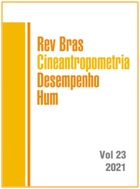Prevalência de Active Play em crianças e adolescentes brasileiros: uma atualização de revisão sistemática para o Report Card Brasil
DOI:
https://doi.org/10.1590/1980-0037.2021v23e84442Palavras-chave:
Saúde Mental, Atenção Psicossocial, Reforma Psiquiátrica.Resumo
Este artigo é uma atualização da revisão sistemática sobre Active Play publicada em 2018 por Mendes et al. Esta revisão sistemática incluiu estudos publicados entre 2018 até 2019. A busca de potenciais artigos foi realizada nas seguintes bases de dados eletrônicas: Pubmed / Medline, Web of Science, Bireme, Scielo e Scopus. Inicialmente, 471 artigos atenderam aos critérios de elegibilidade. Porém, após análise aprofundada, apenas dois estudos permaneceram e foram incluídos na presente revisão. Destes artigos, apenas um apresentou informações individuais sobre a atividade física entre adolescentes de 12 a 17 anos de idade de Curitiba-PR e revelou que 77,2% deles eram fisicamente ativos no tempo livre. O outro estudo foi sobre as preferências por atividades de lazer entre adolescentes de Florianópolis-SC avaliados nos anos de 2001 e 2011. Este apresentou redução significativa na preferência pela prática de atividades físicas, enquanto o contrário foi observado para atividades sedentárias, como assistir TV, jogar videogame e usar o computador. Esses resultados, juntamente com as inconsistências nos pontos de corte do domínio active play entre os países envolvidos na Matriz Global 3.0, deixaram claro a necessidade de uma definição padrão e de uma ferramenta adequada para medi-la.
Referências
Stratton G, Edwards L, Tyler R, Blain D, Bryant A, Jones A, et al. Active Healthy Kids Wales 2018 Report Card. Available from: http://www.activehealthykidswales.com/
Aubert S, Barnes JD, Abdeta C, Nader PA, Adeniyi AF, Aguilar-Farias N, et al. Global Matrix 3.0 physical activity Report Card grades for children and youth: Results and analysis from 49 countries. J Phys Act Health 2018;15(S2):S251-S273.
Mendes AA, Lopes WA, Locateli JC, de Oliveira GH, Bim RH, Simões CF, et al. The prevalence of active play in Brazilian children and adolescents: A systematic review. Rev Bras Cineantropom Desempenho Hum 2018;20(4):395–405.
Moher D, Liberati A, Tetzlaff J, Altman DG. Preferred reporting items for systematic reviews and meta-analyses: the PRISMA statement. J Clin Epidemiol 2009;62(10):1006–12.
Nardo Junior N, Westphal G, Pereira IAS, Borim MLC. Prevalence of active play in Brazilian children and adolescents: a systematic review. PROSPERO 2021 CRD42021236338. PROSPERO 2021 CRD42021236338 Available [Internet]. 2021;1–5. Available from: https://www.crd.york.ac.uk/prospero/display_record.php?ID=CRD42021236338
Silva AA de P da, Camargo EM de, Silva AT da, Silva JSB, Hino AAF, Reis RS. Characterization of physical activities performed by adolescents from Curitiba, brazil. Rev Bras Med Esporte. 2019;25(3).
Bertuol C, Silva KS, Cordeiro V, Filho B, Da A, Bandeira S, et al. Preference for leisure activities among adolescents in southern Brazil: what changed aaer a decade? Rev Psicol Deporte 2019;28:71–80.
HALO. ParticipACTION. The Brain + Body Equation: Canadian kids need active bodies to build their best brains. The 2018 ParticipACTION Report Card on Physical Activity for Children and Youth [Internet]. 2018 [cited 2021 Oct 19]. Available from: www.participACTION.com/reportcard.
Truelove S, Vanderloo LM, Tucker P. Defining and Measuring Active Play Among Young Children: A Systematic Review. J Phys Act Health 2017;14(2):155-166.
Takken T, Jong N, Duijf M, van den Berg S, Wendel-Vos W. Results from the Netherlands’ 2018 Report Card and Report Card+ on physical activity for children and youth with and without chronic medical condition. Public Health 2020;185:161–6.
Takken T, de Jong N; Dutch Physical Activity Report Card Study Group. Results from the Netherlands’ 2018 report card on physical activity for children and youth. J Phys Act Health 2018;15(S2):S388-S389.
Mileva B. Results From Bulgaria’s 2018 Report Card on Physical Activity for Children and Youth. J Phys Act Health 2018;15(S2):S326–7.
Smith M, Ikeda E, Hinckson E, Duncan S, Maddison R, Meredith-Jones K, Walker C, et al. Results from New Zealand’s 2018 report card on physical activity for children and youth. J Phys Act Health 2018;15(S2):S390–2.
Nigerian Report Card on Physical Activity for Children and Youth [Internet]. 2018. Available from: www.nigerianheart.org
Bhawra J, Ranjani H, Krishnaveni G v, Anjana RM, Kumaran K. THE 2018 India Report Card On [Internet]. Available from: www.activehealthykidsindia.com
Roman-Viñas B, Zazo F, Martínez-Martínez J, Aznar-Laín S, Serra-Majem L. Results From Spain’s 2018 Report Card on Physical Activity for Children and Youth. J Phys Act Health 2018;15(S2):S411-S412.
Liu Y, Tang Y, Cao Z-B, Zhuang J, Zhu Z, Wu X-P, et al. Results From China’s 2018 Report Card on Physical Activity for Children and Youth. J Phys Act Health 2018; 15(S2):S333-S334.
Munambah NE. Active Healthy Kids Zimbabwe. Physical Activity and the Nutritional status of school-aged children in Zimbabwe: current research evidence and policy implications. [Internet]. Harare, Zimbabwe; 2018. Available from: www.activehealthykidszimbabwe.com
Tladi DM, Monnaatsie M, Shaibu S, Sinombe G, Mokone GG, Gabaitiri L, et al. Results from Botswana's 2018 Report Card on Physical Activity for Children and Youth. J Phys Act Health 2018;15(S2):S320-S322.
Downloads
Publicado
Edição
Seção
Licença

Direitos Autorais para artigos publicados nesta revista são do autor, com direitos de primeira publicação para a revista. Em virtude da aparecerem nesta revista de acesso público, os artigos são de uso gratuito, com atribuições próprias, em aplicações educacionais e não-comerciais, desde que seja dada a atribuição. Esta obra foi licenciada com uma Licença Creative Commons Atribuição 4.0 Internacional - CC BY


